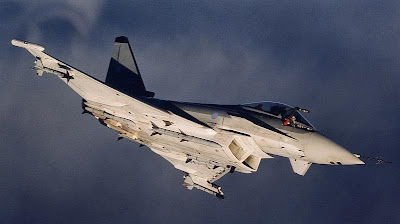
Even though development of the entry level Eurofighter is now nearing completion there are a number of system-wide upgrades either planned or underway. For example the ECR-90 will go through a series of upgrades improving resolution and ECCM before finally it is replaced with an all new solid-state phased array, AMSAR. The EJ200 powerplants also have the capability to be upgraded in both the area of increased thrust and the fitting of a newly designed 3D thrust vectoring control system. These are combined with a contractual requirement that the Typhoon be capable of 100% growth in avionics bus data traffic, 10% growth of equipment fit and a 25% increase in power demands.
Beyond specific upgrades there are several other projects underway which may result in Eurofighter being used in additional roles. In the UK there are currently two future aircraft projects underway, FOAS or the Future Offensive Air System to replace the IDS Tornado's and FJCA ( Future Joint Combat Aircraft)to replace RN and RAF Harrier's. Of these FOAS, a system intended to replace the Tornado IDS in use by Britain, Germany, Italy and Saudi Arabia is the least likely to evolve directly from the Eurofighter. Although BAe have said that a big wing Eurofighter study is underway which may be submitted as a FOAS solution it is very unlikely such a platform would meet demands on all aspect stealth.
The second application, FJCA was a more promising project. The biggest issues in this case are strengthening the landing gear and fuselage to allow arrested recovery of the aircraft and the marinisation of certain potential areas of corrosion. In the case of the former BAE Systems devised some novel solutions. For take-off the Typhoon's excellent short field performance combined with a ski jump ramp should allow for relatively short deck take-offs, removing the need for catapults. For recovery a number of studies were carried out, for example one looked at the use of fans to blow air across the deck while the aircraft lands. This would decrease the required landing velocity and therefore reduce the forces on the aircraft fuselage upon arrest. Other investigations examined linking the Typhoon's FCS to the pitch and roll of the carrier. This would allow automated flared landings to be carried out again reducing stresses on the aircraft.

No comments:
Post a Comment